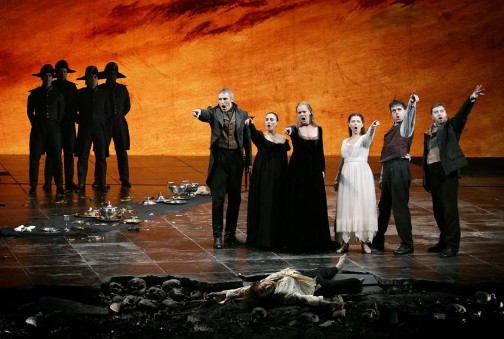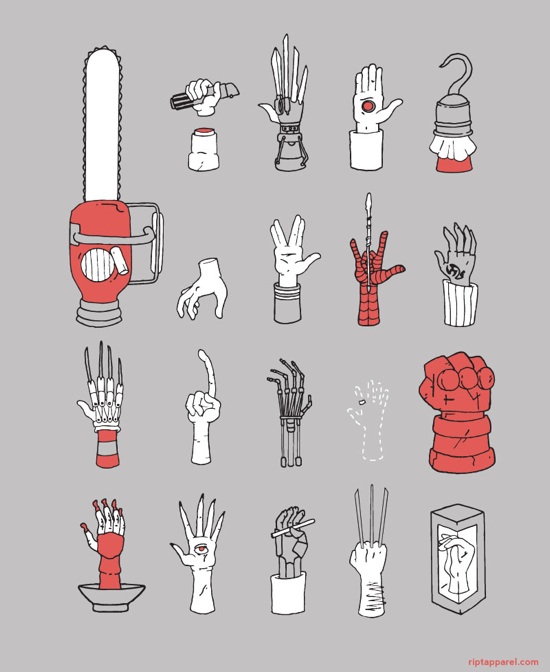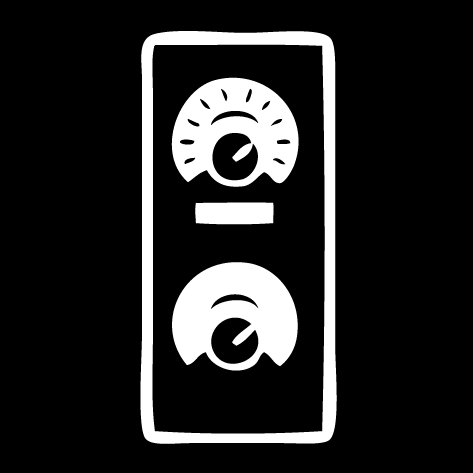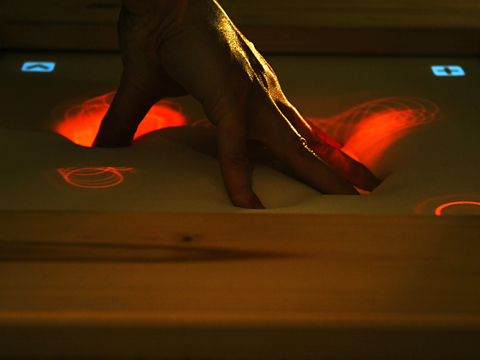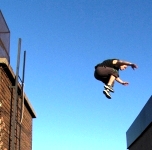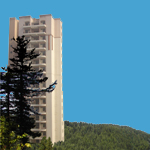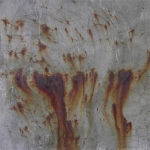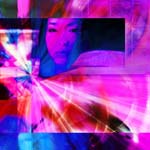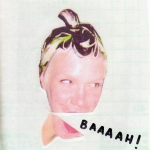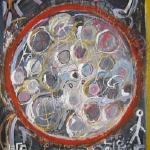Powerplant Family
The Powerplant Family was an artist collective I helped to organize with Lucy May, Naomi Lasry, and Sammono Chau. We held an exhibition called Nature of State, which explored the role of nature in modern life and featured works by 23 artists. I collaborated with Lucy May and Lysandre Coutu-Sauvé to create an interactive dance installation called Play Station #9, described here.
The following material is from the (now offline) Powerplant website.

The nuclear family has mutated. We have taken a look at the soil in which we sit and have found that some of us flourish in our terracotta, while others long to push roots in wider spaces free of concrete. Though each of us is earthed in our own particular little world, we are all exposed to two radiations: nature and urbanity.
Traditionally, these two are seen as warring elements. Although industrial development can devestate the setting in which it lays its foundations, nature (in the broadest sense of the term) persists in exerting a force as strong as steel or red-tape: dandelions push through cracks in the sidewalk, enormous factories erode, patterns of migration emerge at rush hour. And so the characterization of the city as nature’s antagonist, with which we are so familiar, cannot be taken at face value. In fact, when we look closely, the distinction between said opponents dissolves; the city, we realise, is a natural thing.
Our investigation into this convergence will be documented in the exhibition Nature of State. The photographers, sculptors, performers, graffiti writers, dancers, musicians, streetrunners, filmmakers, poets, wanderers and philosophers who have all helped to water and to shed some light on the seed of our theme, will exhibit their findings and reactions between Friday April 7th and Saturday April 15th 2006. The result will be lush.
135 Avenue Van Horne, corner Waverly
Montreal, Quebec

Amélie Anache
Commercial galleries and malls: An indoor natural environment?
Photography
Malls, food courts and underground galleries try hard to make us feel like we are in a natural environment. But are we really taken in by fake plants, fake fountains, and fake pavement?
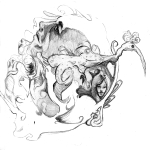
Steve Athanasopoulos
Untitled
Illustration
A series of drawings relating animals to humans.
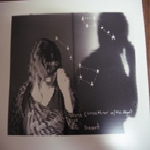
Amber Berson
Polaris
Collage
This piece is about the North Star and how it is constantly changing states. Currently it is Polaris, of the constellation Ursa Minor. In the past it has also been part of the constellations Draco (Thuban), Lyra (Vega), and Cepheus (Alpha Cephei). The star shifts between these constellations independently. To illustrate this, I am using images of our pasts, present and futures superimposed with illustrations of the shifting stars.
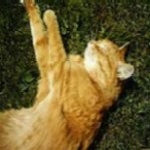
Louise Birdsell Bauer
The Playing Field
Words
We often have stirring exchanges in city park spaces, and that dialogue is the central theme of my short stories. People find release in green spaces, however small or brief the occasion. The emanating feelings, both sensory and cerebral, allow for a renewed inclination to create. The characters in these stories collectively attest to this everyday miracle, occasionally giving us a glimpse into their imagination.
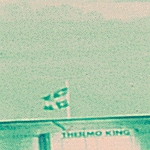
Adrian Buitenhuis
Photography & Installation
Still-video & audio loop
Long exposed colour still photographs of trains entering various Montreal metro stations are matched by the sound recorded during the length of the creation of the image. All images are combined with recorded sound to create a video loop.

Sammono Chau
Vector Sigma
Remote controlled found objects
Vector Sigma is a supercomputer located deep within Cybertron. It is unknown who created it or for what purpose, but it is known that it is capable of granting inanimate robots both life and intelligence.” – WikipediaWhen I was nine, my friend and I were going to build an intelligent robot from a broken calculator we had found. For this project, I, Vector Sigma, will drink lots of coffee and grant new life to discarded objects. My packrat nature, in tandem with my fascination since childhood with circuitry or anything cybernetic (Transformers of course), have had me collecting treasures from numerous street corners and adopting discarded remote controlled toys from work (formerly known as Radio Shack). I have always been shocked and a bit sad to see perfectly good material, most of the time really useful and usable, heaped around town on garbage day. The end result will be an almalgamated being equipped with kinetic movement, its own dialect, and will radiate junk culture vitally, which I witness every day as people flock into my workplace to buy the latest disposable technology.
People usually decline our “Three Year Extended Warranty Repair or Replacement Plan” with the response: “For what it’s worth, I’d rather throw it away and buy a new one.”
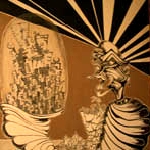
William Colley
Nature’s Boy
Pencil, acrylic
Nuclear Tree Line
Collage, acrylic
Urban Restraints
Acrylic
The-Green-House-Illustrations
Pen & ink illustrations mounted in houseplants
My submission includes three abstract paintings which all have to do with being caught in something greater than yourself, whether it be city or nature, the link to both is there… but my most inspired submission is to be a House Plant installation This installation is composed of three house plants of different sizes, in each plant, an illustration will be found, mounted as if they are a natural part of the whole. The idea is to convey house plants as a new medium for the artist, a platform which one may grow from, artist as plant. But the thought of it is taken further in that many artistic works are produced in confined spaces, apartments, studios, four walls; a mirror image of house plants, of sorts, un-able to connect to the true roots of their natural environments The installation is a means of showing the viewer how the most absurd mind is only as free as the space which it is in; frame of mind, framed images, framed plants, refined nature for the refined artists.
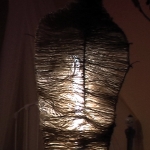
Shawnee deGruchy
Human Cocoon
Sculpture
The main theme of the piece is how humans have evolved and how new scientific discoveries have changed the state of humans. Human Cocoon focuses on rebirth and deals with the question, “What would it look like if humans invented a way to be reborn?”
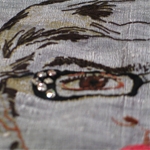
Rachel Dhawan
Sex and Gender
Embroidery on raw silk
Using my own life-size image, I play with the roles we are assigned. This diptych questions the perceived biological nature of sex and gender, while explorng the performance of such identities.

Chris Dyer
Nature is Communicating
Acrylic on a recycled skateboard
Though Nature doesn’t have the sophisticated human means of expression as language, it does have much consciousness and communicates to us constantly. Through the colors of springtime, life, the smells in the air, the food we eat, and drugs we intake, it talks. The chemical message comes across more clearly via Psychadelic intake, and it appears to me that it is saying for us to unite with it instead of creating divisions. To harmonise with a system that is part of us, or continue our mass suicide. Plants definitely have Power and divinity, as everything is a small cell in the giant body of God.
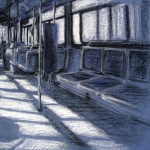
Ana Kusmic
Buses
Conte & acrylic on canvas
My project is about buses. That is, I have drawn an interior of a bus. The bus that I use as transport every single day is the subject. Consider the bus as your walk into the nature when you’re using it. I stare at the bus so much for so long, it really deserves to become a picture and made look pretty for once.
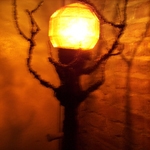
Naomi Lasry
Body, Lamp, Turtle
Installation
The image of the turtle is my reaction or trying to mimic the experience of volunteering in Tortugeuro, Costa Rica, witnessing thousands of tourists invading the endangered sea turtle’s moment to lay its eggs. It resembles a rotting carcass of a turtle, made out of industrial materials. The installation will include this turtle surrounded by sand, whereby the audience becomes the invaders. The turtle finds itself in this modern surrounding, lost yet somehow adapting to the new environment of human activity.
The image of the lamp tree, is like a street lamp revolting, against its destined materials, wants to become nature or in some way just does, and grows arms and resembles that of an organic tree.
The image of me with my crooked spine refers to the body in its present shape and to industrialization and the mechanics of prosthetics.
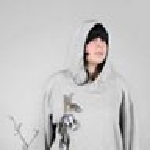
Melissa Matos
Camera Reconstructed
Deconstructed vintage cameras, silver chain & accessories
Having a constant fascination with the idea of deconstructed objects, I am constantly interested in rebuilding them into a new context — giving them new life. Here, I have taken apart broken photographic cameras and used their parts to make accessories which adorn necks, giving them a new purpose and life.
